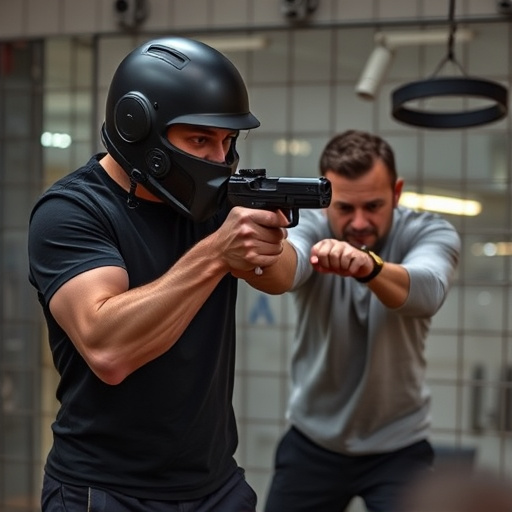Concealed pepper spray carrying techniques involve mastering specific holsters and discreet deployment methods for self-defense. Understanding chemical compounds like oleoresin capsicum (OC) and variations in police-grade sprays is vital for safe and effective use. Responsible handling, local law compliance, regular training, and awareness of rights are crucial for legal deployment, ensuring personal safety without harm to others.
“Discover the power of police-grade inflammatory pepper spray compounds, a game-changer in personal defense. This comprehensive guide delves into the chemistry behind these potent agents, exploring their unique properties and how they differ from commercial varieties. We’ll navigate the legal landscape of concealed pepper spray carrying techniques, highlighting responsible use and safety protocols. By understanding the science and regulations, individuals can empower themselves with this effective self-defense tool.”
- Understanding Pepper Spray Chemistry: Unveiling the Compound
- Police-Grade Strength: How It Differs and Why It Matters
- Concealed Carrying: Effective Techniques for Self-Defense
- Legal Considerations: Regulations and Permits for Pepper Spray
- Training and Safety: Responsible Use and Storage Methods
Understanding Pepper Spray Chemistry: Unveiling the Compound
Pepper spray, a powerful tool for law enforcement and self-defense, is a complex chemical compound designed to cause temporary disability and disorientation. At its core, it’s a capsaicoid, similar to the compounds found in chili peppers that give them their heat. The primary active ingredient in most pepper sprays is oleoresin capsicum (OC), a potent extract derived from chili peppers. This compound irritates the eyes, nose, throat, and skin, leading to a range of physiological responses, including coughing, difficulty breathing, and temporary blindness.
The chemistry behind pepper spray goes beyond OC. Modern formulations often include additional chemicals like chloroacetophenone or ethyl amine, which enhance its effectiveness and duration. Understanding these chemical components is crucial for developing more efficient and safer pepper spray technologies. Moreover, concealed carrying techniques play a significant role in ensuring individuals can access this tool when needed, making knowledge of the compound essential for proper usage and safety measures.
Police-Grade Strength: How It Differs and Why It Matters
Police-grade inflammatory pepper spray compounds are designed with a significantly higher strength and concentration compared to commercial or personal use varieties. This elevated potency is crucial in law enforcement scenarios where rapid neutralization of suspects is paramount. The difference lies not only in the active ingredients but also in the manufacturing processes, ensuring consistency and reliability under high-stress situations.
Understanding these variations in grade is essential for individuals considering concealed pepper spray carrying techniques. Police-grade sprays can provide superior stop-power, but they must be handled with care to avoid misuse and unintended consequences. The right training and knowledge about the unique properties of such sprays are vital to ensure their responsible deployment during self-defense or emergency situations.
Concealed Carrying: Effective Techniques for Self-Defense
Concealed carrying pepper spray is a practical self-defense technique that, when mastered, can be a game-changer in potentially dangerous situations. The key lies in learning effective concealed carrying techniques, ensuring the spray is readily accessible yet discreet. One method involves positioning the spray at the ready in a holster or pouch designed for discrete carry, allowing for quick retrieval with minimal movement. This tactic is especially useful for individuals who prefer to remain calm and tactical during potentially threatening encounters.
Additionally, understanding your surroundings and potential escape routes is vital. By navigating with awareness, you can strategically position yourself and the pepper spray for optimal use if needed. Practicing these concealed carrying techniques, combined with regular training in self-defense, enables individuals to respond effectively while minimizing the risk of injury to themselves or others during a confrontation.
Legal Considerations: Regulations and Permits for Pepper Spray
In many jurisdictions, pepper spray is subject to strict regulations due to its potential for misuse and harmful effects. Before carrying concealed pepper spray, individuals must understand and adhere to local laws. Permits or licenses may be required for possession, especially in certain public spaces like schools, events, or government buildings. These legal considerations aim to balance the benefits of self-defense with public safety concerns.
Concealed pepper spray carrying techniques often involve learning proper storage, deployment, and awareness of one’s rights. Users should familiarize themselves with concealed carry policies specific to their state or region, as these can vary widely. Understanding these regulations is crucial for legal compliance and ensuring that the use of pepper spray remains a responsible last resort in situations where personal safety is at risk.
Training and Safety: Responsible Use and Storage Methods
Proper training is essential for law enforcement officers to handle and deploy concealed pepper spray effectively and safely. This includes understanding the unique properties of various pepper spray compounds, such as their potency, range, and duration of effect. Officers should be trained in different carrying techniques, learning how to secure the spray in holsters or pockets while ensuring easy access during high-stress situations.
Safe storage practices are equally vital. Pepper spray should be kept in designated, locked compartments within police vehicles to prevent unauthorized access. Additionally, regular inventory checks can help track usage and ensure that all officers have access to functional spray when needed. Training should also emphasize responsible use, emphasizing the importance of aiming accurately and minimizing exposure to bystanders or colleagues.
Police-grade inflammatory pepper spray, with its potent compound, serves as a powerful tool for self-defense. Understanding its chemistry, recognizing legal boundaries, and mastering safe handling techniques are essential steps in concealing and effectively using pepper spray for personal protection. By employing proper carrying techniques, staying informed about regulations, and undergoing adequate training, individuals can ensure they are prepared to defend themselves while adhering to legal requirements.
